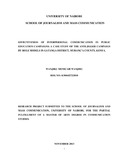| dc.description.abstract | Jigger infestation has been a long term and serious problem in Kenya. Each year, human beings in their prime working age are unable to perform their duties due to regular attacks by the pest. The infestation has severely retarded economic development in the region. The pest threatens to reverse Kenya‘s anticipated gigantic development gains. If the country has to achieve goal number one of the Millennium Developmental Goals (MGDs), of halving poverty by 2015, then this challenge must be immediately tackled. This study investigates the role of interpersonal communication in changing attitudes of individuals and families and in persuading them to adopt the recommended methods of preventing the spread and effects of jiggers. Jigger infestation has become a major health problem, especially in Gatanga District of Murang‘a County in Central Kenya where the menace has reached pandemic levels and where various intervention methods are currently on trial. One of the intervention initiatives has employed the use of celebrities as role models in the campaign against the pandemic. The objectives of the study were to identify the role models used in the anti jigger campaigns and various interpersonal techniques that they apply, establish the levels at which role model messages are effective in changing the perceptions and attitudes of individuals affected by jiggers in the study area and also identifying key messages used in the campaign and their effectiveness in the campaign.
The study was conducted through mixed methods. Questionnaires, key informant interviews and focus groups discussions were employed in collecting data from respondents on their awareness, attitudes, behaviour and opinions in regard to messages used to fight the jigger menace. Secondary data was also used. The mixed method design was used to systematically collect and analyze data to address the specific objectives and answer the research questions of the study. Purposive sampling was used to arrive at the study population. Based on the findings, this research recommends that elaborate awareness campaigns be carried out to sensitize people on how health knowledge may be transposed to safe practices and also help identify the conditions that could promote preventive behavior change and hence mitigating against jigger infestation. | en_US |


